The benefits of warming up indoors before exercising in cold weather
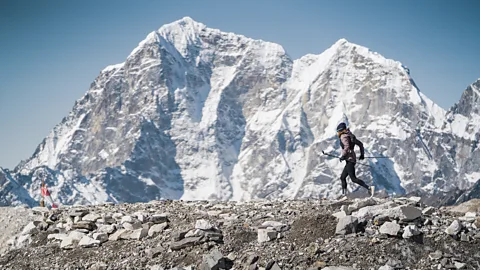 Gabriel Tarso
Gabriel TarsoIt can be difficult to find motivation to keep fit when it's cold and dark outside. Here are some expert tips on how to stay active during the winter months.
Kirra Balmanno has run in some of the coldest places on Earth. The Australian trail runner has crossed wind-swept mountain passes in the Himalayas, running long distances at 6,000m (19,685ft) where temperatures can plummet to -10C (14F).
"Running at high altitudes in these remote mountains excites me," says Balmanno.
Even an ultra-runner like Balmanno struggles to find the motivation to get outside when it's freezing. But she says she rarely regrets it. "Because it is so challenging to run in the cold, to even get out of bed and go for a run, it's great training as an ultra-runner. It's made me more resilient and is a great dopamine release," she says.
It can be tempting to stay in bed and skip your morning jog during the cold, dark winter months. Almost 60% of US adults say they are less active during the winter than they are during the summer.
But getting outside and seeing daylight can help combat winter blues and staying active is important all-year round, experts say, noting that if we take the right precautions winter workouts can be enjoyable, safe and comfortable. So, what are the benefits and drawbacks of exercising in the cold – and what do you need to know for a successful session when it's glacial outside?
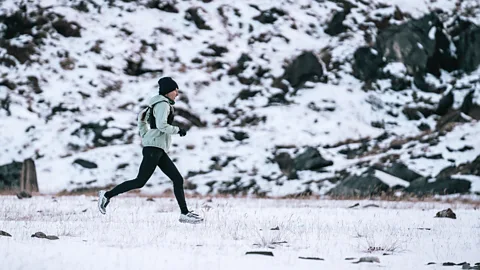 Gabriel Tarso
Gabriel TarsoFighting the winter blues
During the coldest, darkest months of the year, wintertime depression, known as seasonal affective disorder (Sad), can set in. Sad symptoms include a persistent sad or anxious mood lasting at least two weeks, decreased energy, loss of interest in hobbies and oversleeping. (Read more about how the dark days of January shape your mood, intelligence and sex drive).
Studies show that engaging in exercise can help alleviate some Sad symptoms, in combination with bright light therapy.
There is a lack of research into the mental benefits of exercising in cold air, but it is widely known that "exercise is good for mental health", says Mike Tipton, professor of physiology at the University of Portsmouth's Extreme Environments Laboratory in the UK. A 2020 study found that people who do several hours of exercise a week are less likely to develop depression, even if they have a higher genetic risk for the disorder.
Anecdotally, outdoor running at cold, high altitudes has been "really great for my mental health, self confidence and self discipline", says Balmanno. "It has made me more resilient, because it's uncomfortable," she says, "When I'm running alone in the Himalayas, in extreme cold, it can be dangerous, so I have to take real responsibility for my safety. That also helps build confidence in myself and my decisions."
Boosting your resilience
One growing area of research is into the mental health benefits of cold-water swimming, which has become increasingly popular in recent years. Many swimmers say the activity improves brain fog, boosts energy levels and lifts their mood.
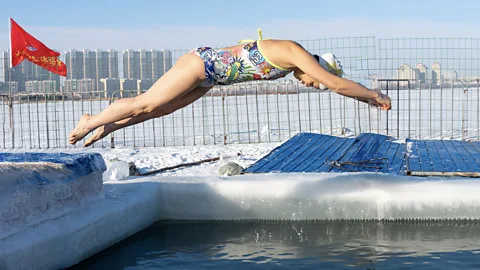 Getty Images
Getty ImagesHeather Massey, a senior lecturer at the University of Portsmouth's Extreme Environments Laboratory, has been researching what happens to the human body in cold water. Immersion in cold water leads to a cold shock response, which drives up your heart rate and blood pressure and floods the body with stress hormones, including adrenaline and cortisol, Massey explains.
This might explain why many people report feeling more alert, refreshed and happier after a swim, says Massey, noting that research is ongoing and there are more "questions than answers at this point".
"The [stress hormones] are heightened during the swim and immediately afterwards you start to experience what we call the 'post swimming high', because you've got this cocktail of hormone responses. It may be that this physiological response gives you that lightening of mood," says Massey. "That's one theory. Another school of thought is that if people can accommodate quite a severe physical stressor, like going into cold water, then they might start to recognise that they can cope with other parts of their life that might be stressful."
Although the research into the mental health benefits is still at a very early stage, Massey says, there is enough evidence to fund clinical trials, including her own study into whether outdoor swimming can reduce symptoms of depression.
For people eager to try outdoor swimming, Massey recommends finding a local group or qualified coach to support you. She also says people with heart problems or underlying health conditions should speak to their doctor before immersing themselves in cold water.
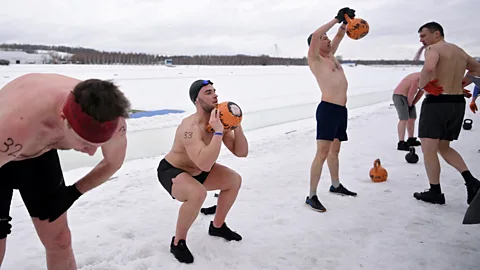 Getty Images
Getty ImagesExercising in cold weather can feel arduous. Experts say there's a physiological reason for this. Cold air acts as "an analgesic", Tipton explains. "Your nerves don't fire as well and your muscular function is impaired because of a [reduction] in blood flow."
The optimal temperature for exercising is 11C (52F), Tipton adds. If it is hotter or colder, performance starts to deteriorate, says Tipton.
We use more energy while exercising in cold conditions, according to John Castellani, research physiologist at the United States Army Research Institute of Environmental Medicine in Massachusetts. "We're not talking large amounts of energy, but it is a little bit higher," Castellani says. This shouldn't affect runners too much as they exercise in light-weight clothes, but hikers, skiers or snowshoers, who are carrying more weight because of heavy clothing and equipment, are likely to burn more energy, he says. "Putting on heavy boots and traversing over loose snow, that adds to their energy expenditure."
While exercising in cool conditions comes with challenges, there are things you can do to make it easier. Here's how to improve your performance and stay safe while exercising in the cold, to help you feel your best all year round.
Warm up indoors
Cold air can also negatively impact your endurance, especially if you do not warm up properly before exercising, research shows. Researchers at Brock University in Canada compared the endurance performance of athletes who waited in different temperatures before they started an intensive bike ride. The first group waited for 30 minutes in a 22C (72F) chamber before they started cycling. For the second group, the 22C temperature was gradually lowered to 0C (32F), over a period of 15 minutes, which caused them to shiver. The researchers found that the cooling effect reduced the endurance (how long they could sustain the exercise before becoming exhausted) of the second group by 31%. A third and fourth group, who only started cycling after their core temperature fell by 0.5C or 1C (0.9F or 1.8F), saw their endurance fall by 30-40%, the study found.
The study findings suggest that staying warm before exercising is critical. "It is a very good idea to warm up indoors before you go outside," says Tipton. "As soon as you step out the door, start exercising. That way you're less likely to get that initial dip in temperature which causes the shutdown of blood flow to the extremities."
Layer up
During the winter, it's important that people run at a comfortable pace and don't tire themselves out so that they end up walking as this is when they will end up feeling cold, says Tipton. It's easier for people to adjust their layers than their running pace, he adds.
"So if you start going uphill, at your normal pace, and you're getting a bit warmer, you could take a layer off and you'd still [have] the perfect heat exchange" says Tipton.
When layering up, it's important that you find the right balance, says John Eric Smith, associate professor of exercise physiology at Mississippi State University. "You want to be warm but not sweating. That's the ideal spot."
"Water is a great conductor of heat – it draws the heat out of our bodies," says Castellani. That's why you should avoid exercising in sweaty or wet clothes when it's cold outside, he says. "As long as you're active and moving, it's not really problematic. It's when you stop or slow down and you're not creating as much heat to stay warm, that's when problems can ensue," says Castellani, recalling how some runners experienced hypothermia during the Boston marathon in 2018, when the weather was wet and windy. This can be particularly problematic towards the end of an exercise session, such as the second half of a marathon, he says.
"The external environment is actually drawing more heat away from people than they're generating themselves and that's when their core temperature starts to fall," says Castellani.
To avoid sweating, experts recommend that you wear several thin layers which you can remove if you're feeling too hot. "The mistake is running in an 'all-or-nothing garment'," says Tipton. "You're much better off wearing layers."
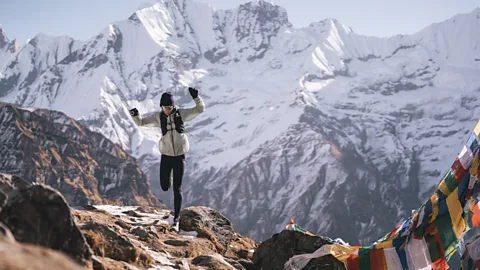 Getty Images
Getty ImagesBalmanno always carries a down (puffer) jacket, merino wool thermals and a water and windproof layer when running in the Himalayas. "It's all about layering. I don't want to sweat so much that my clothes are getting wet as then I have to run over a pass where it's very windy and cold and I get even colder," she says.
Of course, this might not work for everyone – the rate at which people sweat can be highly variable, even in the same environmental conditions. Some people might find that they sweat excessively whatever temperature they're exercising at. But they can still avoid losing too much heat by choosing clothing materials carefully.
Castellani says you shouldn't wear cotton exercise clothes in the winter. "In cold weather, cotton holds onto moisture, so it just continues to draw more heat out of the body," he says. Instead, he recommends wearing moisture-wicking synthetic or natural materials such as polyester, nylon, or silk.
Should you wear gloves and a hat when exercising outside?
You might not need to wear gloves if you have enough layers on and are keeping your core temperature up, says Tipton. The best way to keep your fingers and toes warm is to keep blood flowing to them, because they don't generate heat themselves, he explains.
But you might want to consider wearing a hat as "you lose quite a lot of heat through your head", says Tipton.
For cold water swimming, Massey recommends that people keep warm before they start their swim and immediately change into warm, dry clothes afterwards.
Drink enough water
One mistake many people make is that they don't drink enough water when exercising outdoors during the winter, experts say.
"Breathing cold air can very quickly dehydrate you," says Tipton. Cold air has less moisture than warm air. We add moisture when we breathe in the dry air so as we exhale, we are "losing quite a lot of fluid", he says. "It's also why we get dehydrated in air-conditioned environments because the air is cool and dry."
"Some studies show people actually become more dehydrated in cold and cool conditions than in hot weather, because the need to drink water is not top of mind," says Smith.
Smith recommends that people do their own sweat test to determine how much fluid and electrolytes they need to consume in cold weather and for different distances. "It's simple: you just weigh yourself before and after your exercise session, accounting for any fluid or food that you consume during that time," he says.
Balmanno says she always carries at least 500ml to a litre of water when she's running in cold environments and that she rehydrates after her run with electrolytes.
Despite the challenges, there's no reason to put off your winter run or bike ride as long as you are taking the right precautions, says Tipton. "If you layer up and hydrate, you should be fine."
Outdoor exercise, whatever the season, is always worth making time for, says Balmanno. "It's such an easy thing we can do that has such a big impact on the inside, even if it's just a five-minute jog. The hardest part is getting out the door. Once you're out there, you're golden."
--
For trusted insights into better health and wellbeing rooted in science, sign up to the Health Fix newsletter, while The Essential List delivers a handpicked selection of features and insights.
